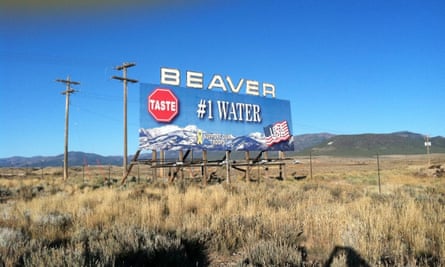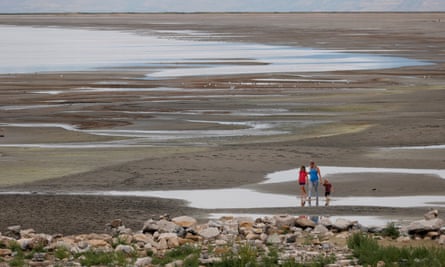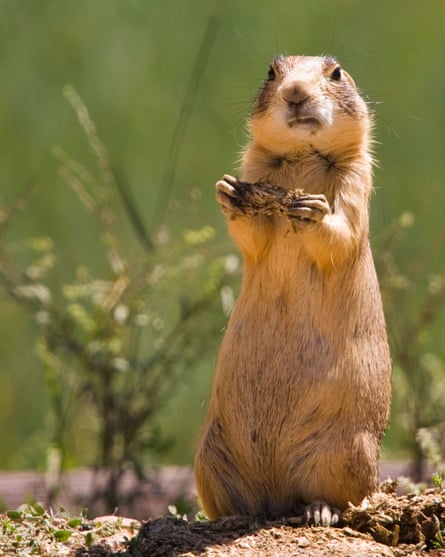The ground in Cedar Valley is sinking and splintering. Fissures that snake through the region are a visible sign of Utah’s water woes, and the result of years spent overdrawing from an underground aquifer that supplies the area.
And yet Cedar City, at the heart of the valley, continues to grow. Visitors flock to nearby national parks such as Zion and Bryce Canyon, adding to the flow of new residents expected to move here in the coming years. Cedar City is already the most populous in Utah’s Iron county, and finding more water has become an existential quest.
Local officials have landed on a controversial solution – siphoning it from under an undeveloped valley to the north in neighboring Beaver county. Laced with scientific uncertainty, the proposal has united environmentalists, ranchers, tribes and officials from other counties in opposition. Supporters, meanwhile, say the city has a legal right to the groundwater and that it is essential for its growth and survival.

The battle is just the latest frontline in the water wars of the American west that have defined Utah’s history. The outcome could have far-reaching implications for the parched landscapes and the people, plants and animals that dwell on them.
“In the west we have the three W’s man will fight for until the day we are all gone – that’s whiskey, women and water,” says Mark Whitney, the commission chair of Beaver county, wryly echoing an old adage he says has circulated for centuries. But as the west dries and its most essential resource grows scarce, this battle may be a glimpse of the future rather than a reflection of the past.
‘If it’s not there, it’s not there’
Cedar City, tucked between arid ranges and pine-covered red-rock mountains, has a historic downtown that caters to its tourists and roughly 35,000 residents. The scenic city is small by most standards, and officials claim they lack the resources to conserve water the way larger cities like Las Vegas and Los Angeles do. But they aren’t the first to seek out new supply even as water levels shrink across the west.
“That’s the problem in the whole state right now,” Whitney . “There are too many straws stuck in the ground.”

Cedar City’s proposal is the culmination of decades of legal challenges. The Central Iron County Water Conservancy District (CICWCD), which supplies water to Cedar City and its surrounding areas, filed for water rights in three valleys outside the county back in 2006. Litigation went on for years amid opposition, before a 2019 settlement cleared the way for the agency to seek federal approval to begin pumping.
The project, still awaiting the all-clear from the Bureau of Land Management, would kick off in Pine Valley, where the CICWCD plans to pump 15,000 acre-feet of water – or nearly 5bn gallons – a year. It would also include a new 200-acre solar facility exclusively built to power the project, and a roughly 70-mile pipeline that, if approved, will traverse across public lands.
The plan comes at a desperate time. The south-west is experiencing the driest period in more than 1,200 years, according to scientists, and Utah is one of the driest states in the country. Even now, in early spring, more than a third of the state is classified in extreme drought by the US Drought Monitor. Driven by the climate crisis and development, temperatures are also spiking, which will only speed up scarcity.
But Whitney says the battle to protect his county’s water isn’t just about politics. It’s science.
Pulling more water out from the undeveloped systems could have far-reaching effects that even extend across state lines. Some models question whether enough water exists in Pine Valley to fulfill what the agency plans to pump. “You can own all the water in the world,” he said, “but if it’s not there, it’s not there.”

The water in question flows hundreds of feet beneath the hard desert earth, tucked between mountain ranges along the Utah-Nevada border. As part of a broader system, the groundwater in the valley basins across the region sustains nearby streams and small wetlands. The area is sparsely populated, but cattle that roam these ranges share natural spring water with wild horses, elk and antelope. Coyotes and foxes traverse the wildlands used as nesting sites for migratory birds and eagles.
The valleys are also habitat to species with dwindling numbers, including the greater sage grouse, the Utah prairie dog and springsnails. Krista Kemppinen, a senior scientist with the Center for Biological Diversity, an environmental advocacy organization that opposes the project, also points to a tiny imperiled fish called the least chub. Some scientists believe the project will push it closer to extinction, with irreversible effects.
“Even when you lose just one species, that can disrupt an entire ecosystem,” said Kemppinen.
But opinions differ on how drastically these landscapes – and those who rely on them – will be affected once the water is pulled out from under them. Driving that uncertainty is the fact that scientists and officials aren’t exactly sure where the water flows now, and which landscapes stand to lose if the groundwater is redirected.
With so many variables at play, projections can change dramatically when models account for shifts in precipitation, runoff or heat that affects evaporation and dryness.

The BLM’s draft environmental assessment, which relies on data and analysis compiled by federal scientists and a contractor hired by the CICWCD, predicts that the proposal will have limited effects outside the project area. But Paul Briggs, BLM’s field manager for Cedar City, says there is “absolutely uncertainty” about long-term effects.
“We can’t see underneath the ground any better than anybody else and we are very upfront about that in the analysis,” said Briggs. “We won’t know the exact impacts of something like this until we are several years into the development and pumping of it.”
Earlier models from the US Geological Survey paint a more problematic picture. In a 2019 report, the agency concluded that the valley in question may yield less than 75% of the water the agency hopes to acquire each year. The drawdown could pull water from connected basins, affecting areas far from the project itself. Scientists say the taps may be hard to turn off once the changes to the water system are put into play.
A separate analysis conducted by the Great Basin Water Network, a coalition of water conservation advocates who oppose the plan, which relied on the USGS data, found that the project “could result in lasting water resource impacts” to surrounding valleys and the ecosystems that depend on them, possibly even stretching into Great Basin national park and Fish Springs national wildlife refuge.

Briggs emphasized that monitoring and mitigation plans will be put in place if it is approved, adding that he believes the agency is relying on the best science to make a decision. But others aren’t as confident. While few people call this land home, those that do say the cost could be high.
Mark Wintch, a multi-generational rancher in the adjoining Wah Wah Valley, is worried about the natural spring that waters both cattle and crops and produces hydroelectricity that runs the ranch and his house, where he and his wife have raised six kids.
If the proposal moves forward, that spring is going to run dry. “My family has run this operation since 1898,” Wintch said. “This project has the potential to take everything away.”
Accusations of trampled Indigenous water rights
Paul Monroe, the general manager of the CICWCD, counters the claims of ecological breakdown, citing the layers of contingency plans being put in place to protect the environment. The district is prepared to slow pumping if unforeseen consequences arise. And, he said, there’s a lot at stake if the project doesn’t move forward.
Local water use, which was already close to triple the national average in 2020, has been on the rise. The state has finally cracked down on Cedar City’s overdrawing of its aquifer, limiting what can be pumped in the years to come.
“Not only do we have an issue of supplying water for the growth that has been coming but we really won’t have enough water in the future for our current residents who are here now,” Monroe said.
Critics have called on the agency to do more to conserve rather than search out new sources of supply. Monroe claims there has been progress, noting that the county is installing basins to collect runoff water and creating new reservoirs for rural use, which he says accounts for most of their consumption. There are also plans for diverting more treated sewer water for irrigation so farmers can idle their underground wells.
But, he claims, the rural municipalities lack the resources to tighten their belts further and conservation alone won’t be enough to sustain the city. After years of waiting, officials are eager to tap into new supply. “We know our standing,” Monroe said, adding that they had done everything by the book. “We are moving forward with the project.”

Kyle Roerink, the executive director of the Great Basin Water Network, doesn’t buy the idea that the agency will turn off the taps if things go awry. “They drained their own aquifer in their own community,” he said. “Can we trust them to be responsible stewards of water that they are importing?”
Opponents also have questions about whether the state was legally able to issue the rights to water underneath Beaver county. Pine Valley, where the project is planned, was also once home to Indigenous nations who now claim they were not adequately consulted and that their water rights on the land have historically been violated and ignored.
“That water is ours – it just has not been adjudicated,” said Tamra Borchardt-Slayton, chairperson of Indian Peaks Band of the Paiute Indian Tribe of Utah.
The draft environmental impact statement references comments from tribes and bands throughout the region who raised concerns about how the project will affect their ancestral land, cultural resources and tribal water rights. Briggs, from the BLM, said the agency has worked closely with tribes and that communication has been open and ongoing. But Borchardt-Slayton describes the BLM consultation as inadequate. “They essentially erased us from that area,” she said.
Rancher Wintch, meanwhile, fears that even if this project is halted, it’s still a sign of what lies ahead as continued growth collides with age-old water conflicts in this remote corner of the south-west. “The biggest takeaway is that water really was the gold rush of the west and it’s the most valuable thing we have,” he says. “It’s so precious and we have got to protect it.”
